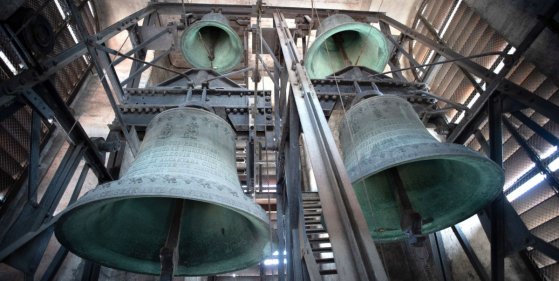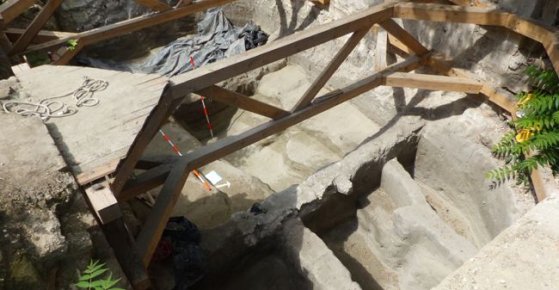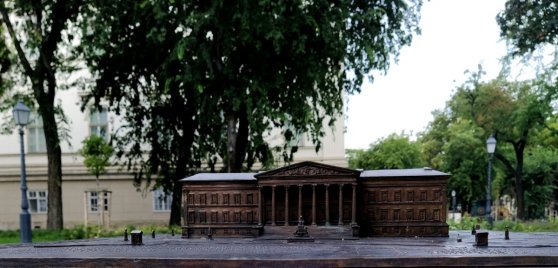 The „intertwined history” of the bridges and the city of Budapest
Which ideas and events have shaped the fate of bridges of Budapest and the cityscape? Alongside many other interesting facts, this question is also answered this newly published book by the Budapest City Archives, which introduces the history of bridges in Budapest.
The „intertwined history” of the bridges and the city of Budapest
Which ideas and events have shaped the fate of bridges of Budapest and the cityscape? Alongside many other interesting facts, this question is also answered this newly published book by the Budapest City Archives, which introduces the history of bridges in Budapest.
pestbuda.hu
 Christmas Market on Vörösmarty Square cancelled
Christmas Market on Vörösmarty Square cancelled
October 13, 2020 at 6:44 PM
Due to expectations that the COVID-19 epidemic will reach its peak in Hungary during the advent period the traditional Christmas market held every year on Vörösmarty Square has been cancelled.
Béla Bartók left Hungary 80 years ago and died five years later
October 13, 2020 at 9:00 AM
Bartók is one of the greatest composers of the 20th century. His life was deeply connected to Budapest. His career began the city, and he left for the United States from here 80 years ago. On the 75th anniversary of his death pestbuda.hu visited the most important sites of his life in Budapest.
Government to create 3000 P+R parking spaces to reduce traffic in Budapest
October 12, 2020 at 7:30 PM
A government decree recently published in the official Hungarian Gazette allows planning of over three thousand P+R parking spaces and storage for at least two thousand B+R bicycles to begin this year. The hope is that the improved facilities will encourage people living in the Budapest agglomeration to travel into the city centre by train or suburban railway and contribute to a reduction in traffic.
Parliament or Palace? – Construction of the Hungarian parliament began 135 years ago
October 12, 2020 at 5:58 PM
On 12 October 1885 150 workers began to dig a 40,000-cubic-metre pit. With this construction of the Hungarian parliament building began based on plans drawn by Imre Steindl. Lasting nearly two-decades the project transformed a neglected, to-be-developed part of the city, Tömő tér, into one of the most symbolic places in the country.
Liveable Budapest? The first plans were made 80 years ago
October 11, 2020 at 1:00 PM
Budapest adopted its first modern urban development plan in 1940. The massive 150-page document took eight years to prepare. Its main goal was to provide a livable environment for the inhabitants of the quickly growing city. The plan accounted for an increase in motor traffic, marked routes for underground railways, and pushed for architecturally unified residential areas. It also contained plans for the creation of community gardens in the densely populated areas of Pest and designated the embankment as an expressway for vehicles.
Livable Budapest? The first plans were made 80 years ago
October 11, 2020 at 1:00 PM
Budapest adopted its first modern urban development plan in 1940. The massive 150-page document took eight years to prepare. Its main goal was to provide a livable environment for the inhabitants of the quickly growing city. The plan accounted for an increase in motor traffic, marked routes for underground railways, and pushed for architecturally unified residential areas. It also contained plans for the creation of community gardens in the densely populated areas of Pest and designated the embankment as an expressway for vehicles.
A place of beauty in the heart of the city – 225 years of Bakáts Square
October 10, 2020 at 12:00 PM
There are few places in modern Budapest where the defining institutions of community life can be found side by side. There may not even be such a place any more. Nevertheless, one-hundred or one-hundred and fifty years ago people believed it was vital that they not have to cover large distances to go to church, drop their Children of at school, reach a hospital quickly or sort official matters out. It was best, if church, school, hospital, administrative offices or maybe even a cinema or social club could be found nearby. Bakáts Square was just such a place.
Zugló turns 85 – A district of palaces, villas and housing estates
October 9, 2020 at 3:00 PM
Established ninety years ago, Zugló became an independent district 85 years ago. The 14th District connects the city centre with the outer parts of the city, and its role is reflected in its architecture. Beautiful villas built by artists stand alongside stunning school buildings, monuments and the headquarters of various institutions in the styles of historicism and Art Nouveau and these were joined in the 1970s by housing estates.
Founded 70 years ago the KFKI served as a meeting place for Nobel laureates
October 8, 2020 at 2:00 PM
The Central Physics Research Institute, KFKI was established in Csillebérc seventy years ago. Near Normafa the institution quickly became a central location of scientific and academic life in Hungary and was visited by several Nobel Prize-winning researchers. The first nuclear reactor in Hungary, which is still operational, was built here, and the Pille radiation dose meter was also developed on the campus. Scientists awarded by NASA have also worked within its walls. Divided into several divisions after the end of socialism in Hungary, Csillebérc still houses committed researchers.
A bridge without a name – How Chainbridge in Budapest had no name
October 7, 2020 at 11:00 AM
Chain Bridge in Budapest had no official name until 1915 and is still known simply as Chain Bridge in everyday use. However, Lajos Kossuth proposed in 1842 at the laying of its foundation stone that the bridge be named after his great political rival, István Széchenyi, the aristocrat who initiated the construction. Others hoped to name the first permanent crossing between Buda and Pest after princes and princesses. Still, the Ministry of Finance that owned the bridge accepted none of these recommendations. Finally, Széchenyi's name was carved into the structure in 1915, when it was fully rebuilt during the First World War.
Master bell founder Laszlo Szlezák born 150 years ago
October 6, 2020 at 3:00 PM
László Szlezák is possibly one of the best-known Hungarian bell-founders. He came to Budapest at the age of 14 and cast beautiful bells for churches throughout the city. Several of them can still be seen, for example in the Reformed Churches in Angyalföld and on Városligeti Avenue, on Ferenciek Square, in the Catholic Church on Haller Street, and the Kőbánya Church designed by Ödön Lechner. His largest and most famous work, the 7945 kg Saint Emeric bell cast for Saint Stephen's Basilica was destroyed in the Second World War.
Volga taxis appeared in Budapest 60 years ago
October 5, 2020 at 10:00 AM
In the 1950s only Főtaxi, owned by the city itself, was allowed to provide taxi services in Budapest. The company had relatively few vehicles in its very diverse fleet. At the beginning of the new decade, they purchased new vehicles from the Soviet Union, which they believed would become the basic taxi in the capital. The Volga M21 was unable to fill this role, and 10 years later, another car took the streets of the capital by storm: the Zhiguli.
How a road to Vienna resulted in a re-evaluation of Budapest
October 3, 2020 at 2:00 PM
The Budapest–Vienna Highway was specifically designed for cars and opened 90 years ago, on 4 October 1930. Public opinion in the country and the capital hoped that the new road would improve Hungary's geopolitical situation and improve tourism. Perhaps not many readers know that drivers would have had to leave the capital through Bécsi Road (Bécs is the Hungarian name for Vienna) in the 3rd District to reach the Austrian capital.
New rail bridge being built between Ferencváros and Lágymányos
October 2, 2020 at 11:00 AM
The bridge being built is the sixth structure to connect the tracks on the two sides of the Danube beside Rákóczi Bridge. However, the current construction is unique, as it is similar to threading a thread through a needle. See the photos of the unique procedure below.
Art Nouveau meets the modern world – The final building planned by Albert Kőrössy Kálmán
October 1, 2020 at 11:00 AM
The renovation of the villa under 26 Benczúr Street was recently completed. The exterior designed by Albert Kálmán Kőrössy has remained an art nouveau villa, while the interior has become a modern space, equipped with state-of-the-art technology. Build as a residential building, it later became a language examination centre, and now houses a centre for education and innovation.
Replanned twice by the great Ybl – Construction of the Main Customs House began 150 years ago
September 30, 2020 at 10:00 AM
The stunning Renaissance revival palace of the Main Customs House by Miklós Ybl is better known today as Corvinus University. The building has defined the view of the Danube embankment since its completion. A lesser-known fact about the building is that it was initially planned for Kossuth Square. Foundation work began but later stopped when Gyula Andrássy (the prime minister in office at the time) supported the Budapest City Council in the dispute about the site. The building was moved to Ferencváros, and Ybl was forced to redraw his plans for the palace twice before construction began 150 years ago.
Statue of Saint Stephen may be erected in Kispest, not Saint Stephen's Park
September 29, 2020 at 5:00 PM
Budapest City Council to vote on the question of where a new statue of Saint Stephen will be erected on 30 September. The statue was originally planned for Saint Stephen's Park in the 13th District, but the proposal is to erect it on Templom Square in the 19th District. The Wallenberg Monument, the monument to Heroic Budapest Partisans, and a statue of Ferenc Fejtő currently stand in the park. The statue of the communist People's Commissioner György Lukács was removed in 2017.
The 250 years of Semmelweis University – Exhibition opens in the Museum of Medical History
September 28, 2020 at 2:00 PM
The Faculty of Medicine of the Nagyszombat University (present-day: Trnava, Slovakia) founded by Péter Pázmány was established on 7 November 1769 by the decree of Queen Maria Theresa. The first academic year began on 8 November 1770. The exhibition entitled from Nagyszombat to Klinikák – Teaching, Tradition and Innovation has been opened to commemorate the 250-year anniversary of this.
Hospital on the outskirts – Huge effort by 19th-century decision-makers improved healthcare
September 28, 2020 at 9:00 AM
The construction of Saint John's Hospital (Szent János Kórház) began 125 years ago, on a hillside where vineyards had once stood. The 300-bed modern hospital was much needed, as the old building of the hospital, on the present-day Széna Square, was gravely overcrowded. Doctors feared that the influx of workers to the capital caused by the construction of projects connected to the upcoming national millennium would lead to catastrophe.
The baroque splendour of Óbuda – A palace visited by Maria Theresa
September 26, 2020 at 6:00 PM
The Zichy Palace on the main square of Óbuda (Fő tér) once housed a luxurious lifestyle. The building's baroque splendour, ornate gates, large interiors, its ballroom, billiard room and shooting range, alongside its garden with fountains and exotic plants guaranteed both entertainment and rest. Even Queen Maria Theresa visited the famous palace, where concerts and theatrical performances were commonplace, and even the count himself acted. What has remained of the legacy of the Zichy family?
Research into what was once the Pest city wall
September 26, 2020 at 1:00 PM
Archaeologists have carried out excavations in Bástya Street in the pest city centre, where part of Pest's city wall once stood. The dig led to finds from the 13th century to the Ottoman Period, including the remains of houses, kilns and ditches.
House of Hungarian Music wins international prize
September 25, 2020 at 5:00 PM
The House of Hungarian Music has been named the best musical real estate development project in the world at the Music cities Awards in the United States. The building is now structurally complete, and the most spectacular parts of its construction are nearing finalisation.
Two-hundred years of shipping in Budapest – New exhibition opened on Kossuth Museum Boat
September 24, 2020 at 5:00 PM
A new exhibition entitled Budapest from the Danube – Pictures from 200 years of shipping in Budapest has opened on the Kossuth Museum Boat anchored on Vigadó Square. The exhibition highlights the most interesting moments of the past two-hundred years of shipping and boat travel in Budapest and opens on Wednesday.
95 years of radio broadcasts in Budapest
September 24, 2020 at 11:00 AM
Hungarian radio had a difficult start. In its first years, listening to the radio without a license was a punishable offence, and permission to access the service was even required later. In the autumn of 1925 chaos reigned: the radio tower in Csepel had been completed, and the studio in Budapest was also being built, but many listened to the experimental broadcasts without permission and ended up in court.
Technical acceptance procedure on southern section of M3 metro begins
September 23, 2020 at 5:00 PM
Metro line M3 is planned to reopen to passengers at the end of October, following the acceptance procedures.
The last unpaved road of Budapest will soon disappear
September 23, 2020 at 9:00 AM
The final dirt roads found in Budapest will be paved in the coming months. The government will provide 5 billion HUF towards the asphalt work in the outer districts of the city.
Renovated Dreher Museum of Beer to reopen
September 22, 2020 at 9:00 AM
The completely revitalized Dreher Museum of Beer will reopen tomorrow with one of the largest collections related to beer in the country. The artefacts in the museum showcase the unique history of not only brewing beer, but the Dreher Brewery: technical and manufacturing equipment, mock-ups, flags, posters, photographs, films, and works of fine art. Visitors will be welcomed from 23 September with digital and interactive content, and beer tastings.
Graves from the Ottman-era and medieval walls found on Margit Boulevard
September 21, 2020 at 6:00 PM
A cemetery from the Ottoman-era has been found during excavation under 19–21 Margit Boulevard. Archaeologists are now searching for the walls of the houses of Felhévíz.
Vigadó of Buda and a family house in Hűvösvölgy named Houses of the Year
September 21, 2020 at 1:00 PM
The winners of the House of the Year competition have been announced. The renovation of the Vigadó of Buda won accolades in the public building category, while a family home in Hűvösvölgy one in the house category.
A place of secrets – A visit to the garden of the National Museum
September 20, 2020 at 12:00 PM
The Night of Artefacts was held this week in Budapest, Between 17–19 September. As part of the event, a walk entitled The Secrets of the Museum Garden was led by Béla Debreczeni-Droppán in the garden of the National Museum.
More articles
 The „intertwined history” of the bridges and the city of Budapest
Which ideas and events have shaped the fate of bridges of Budapest and the cityscape? Alongside many other interesting facts, this question is also answered this newly published book by the Budapest City Archives, which introduces the history of bridges in Budapest.
The „intertwined history” of the bridges and the city of Budapest
Which ideas and events have shaped the fate of bridges of Budapest and the cityscape? Alongside many other interesting facts, this question is also answered this newly published book by the Budapest City Archives, which introduces the history of bridges in Budapest.
 The Bridge Report, which brought a turning point in the history of Budapest
A travel report that changed the history of Pest and Buda, as well as Hungary. The little book contributed to the change of half a thousand years of legal customs and the implementation of an investment of unprecedented size and technical quality. This book was The Bridge Report [Hídjelentés in Hungarian].
The Bridge Report, which brought a turning point in the history of Budapest
A travel report that changed the history of Pest and Buda, as well as Hungary. The little book contributed to the change of half a thousand years of legal customs and the implementation of an investment of unprecedented size and technical quality. This book was The Bridge Report [Hídjelentés in Hungarian].
 Drama on the university wall - The heroic monument was planned 95 years ago
In the constant hustle and bustle of the Egyetem Square in Pest, the students may not even notice the monument that decorates the short section of wall between the church and the central building of ELTE. However, it commemorates their predecessors, the heroes who fought for their country in World War I, and those who heroically helped them. The first design of the dramatically collapsing soldier was born in 1928, ninety-five years ago.
Drama on the university wall - The heroic monument was planned 95 years ago
In the constant hustle and bustle of the Egyetem Square in Pest, the students may not even notice the monument that decorates the short section of wall between the church and the central building of ELTE. However, it commemorates their predecessors, the heroes who fought for their country in World War I, and those who heroically helped them. The first design of the dramatically collapsing soldier was born in 1928, ninety-five years ago.




























